
Pallet restacking plays a pivotal role in supporting Environmental, Social, and Governance (ESG) goals across the U.S. industrial sector. As businesses strive to balance operational efficiency with sustainability, restacking pallets emerges as a practical, cost-effective strategy to reduce waste, optimize resources, and enhance supply chain transparency. This article explores how pallet restacking integrates into sustainable logistics frameworks, the environmental benefits it offers, and how leading companies like Freitty drive this transformation in warehousing and freight handling.
Pallet Restacking and ESG: A Modern Industrial Synergy
ESG initiatives have become a central focus for U.S. industrial firms, shaping decision-making at every level. Pallet restacking, while often overlooked, directly contributes to the environmental and governance pillars of ESG. By ensuring freight is securely and efficiently arranged, companies minimize product damage and reduce the need for repackaging or disposal—two factors that generate unnecessary waste and costs.
Incorporating pallet restacking into daily operations aligns with broader sustainability goals by decreasing material usage and promoting responsible freight management. This synergy enhances warehouse efficiency while supporting regulatory compliance and corporate responsibility standards.
Reducing Waste Through Smarter Freight Handling
One of the most immediate ESG benefits of pallet restacking lies in waste reduction. Improperly stacked pallets can lead to damaged goods that must be discarded or reworked, consuming additional packaging materials and energy. Effective pallet restacking helps maintain cargo integrity, avoiding product loss and reducing landfill contributions.
Moreover, restacking enables the recovery and reuse of packaging materials such as stretch wrap and pallet boards, further lowering environmental impact. Businesses that prioritize these practices showcase their commitment to sustainable logistics and resource conservation.
Energy Efficiency and Resource Savings
Efficient pallet restacking also supports energy conservation across the supply chain. By stabilizing freight loads, transportation becomes safer and more predictable, reducing the risk of accidents that cause costly delays and fuel waste. Additionally, optimized pallet configurations maximize space utilization in trucks and warehouses, meaning fewer shipments and less energy consumption per unit moved.
Smart pallet restacking workflows, often integrated with automation and AI tools, reduce manual labor and minimize equipment run-time. This combination leads to tangible resource savings and helps companies meet energy reduction targets set by ESG frameworks.
Compliance, Reputation, and Regulatory Alignment
ESG compliance often requires firms to document their sustainability efforts and minimize environmental risks. Pallet restacking contributes by lowering damage rates and demonstrating proactive risk management. It supports governance objectives by improving operational transparency and aligning with industry standards such as ISO 14001 (Environmental Management) and other freight handling certifications.
From a social perspective, safe and efficient pallet restacking improves working conditions by reducing workplace hazards related to unstable loads. This fosters better employee morale and reinforces corporate social responsibility commitments.
Case Spotlight: How Freitty Integrates ESG Through Pallet Restacking
Freitty, a leading logistics innovator based in Denver, Colorado, exemplifies how pallet restacking can drive ESG goals in practice. Freitty’s approach combines traditional expertise with cutting-edge technology to offer freight rework solutions that reduce waste, optimize space, and improve safety across warehouses.
By leveraging AI-powered diagnostics and smart warehousing systems, Freitty streamlines pallet restacking processes to minimize turnaround time and resource consumption. Their focus on sustainable logistics supports clients’ ESG reporting requirements while delivering measurable economic benefits. Explore their offerings at Freitty.com.
Freight Optimization and the Bigger Environmental Picture
Pallet restacking is a crucial element of broader freight optimization strategies that contribute significantly to green supply chains. When freight is restacked correctly, companies can consolidate shipments, lower transportation frequency, and reduce carbon emissions.
This optimization aligns perfectly with global efforts to decarbonize logistics networks and reduce industrial footprints. The ripple effects of pallet restacking extend beyond warehouses to highways and ports, creating more sustainable and resilient supply chains.
Why Pallet Restacking is a Long-Term ESG Investment
Investing in pallet restacking capabilities is a strategic move for businesses committed to ESG principles. Beyond immediate operational gains, it demonstrates a dedication to continuous improvement and environmental stewardship.
Businesses that integrate pallet restacking into their sustainability roadmaps benefit from enhanced brand reputation, regulatory favor, and cost savings. They also position themselves to adapt swiftly to evolving ESG expectations and market demands.
Conclusion: Aligning Business Strategy with ESG through Logistics Innovation
Pallet restacking, though a seemingly simple process, supports complex ESG goals by reducing waste, enhancing safety, and promoting resource efficiency. Companies like Freitty prove that embracing such operational innovations leads to measurable environmental and economic advantages.
As the U.S. industrial sector continues its journey toward sustainability, pallet restacking stands out as a practical and impactful tool. Incorporating it into your warehousing and freight handling strategy today can secure both compliance and competitive edge for tomorrow.
pallet restacking ESG logistics sustainable warehousing freight optimization industrial ESG impact Freitty green supply chain warehouse efficiency


















